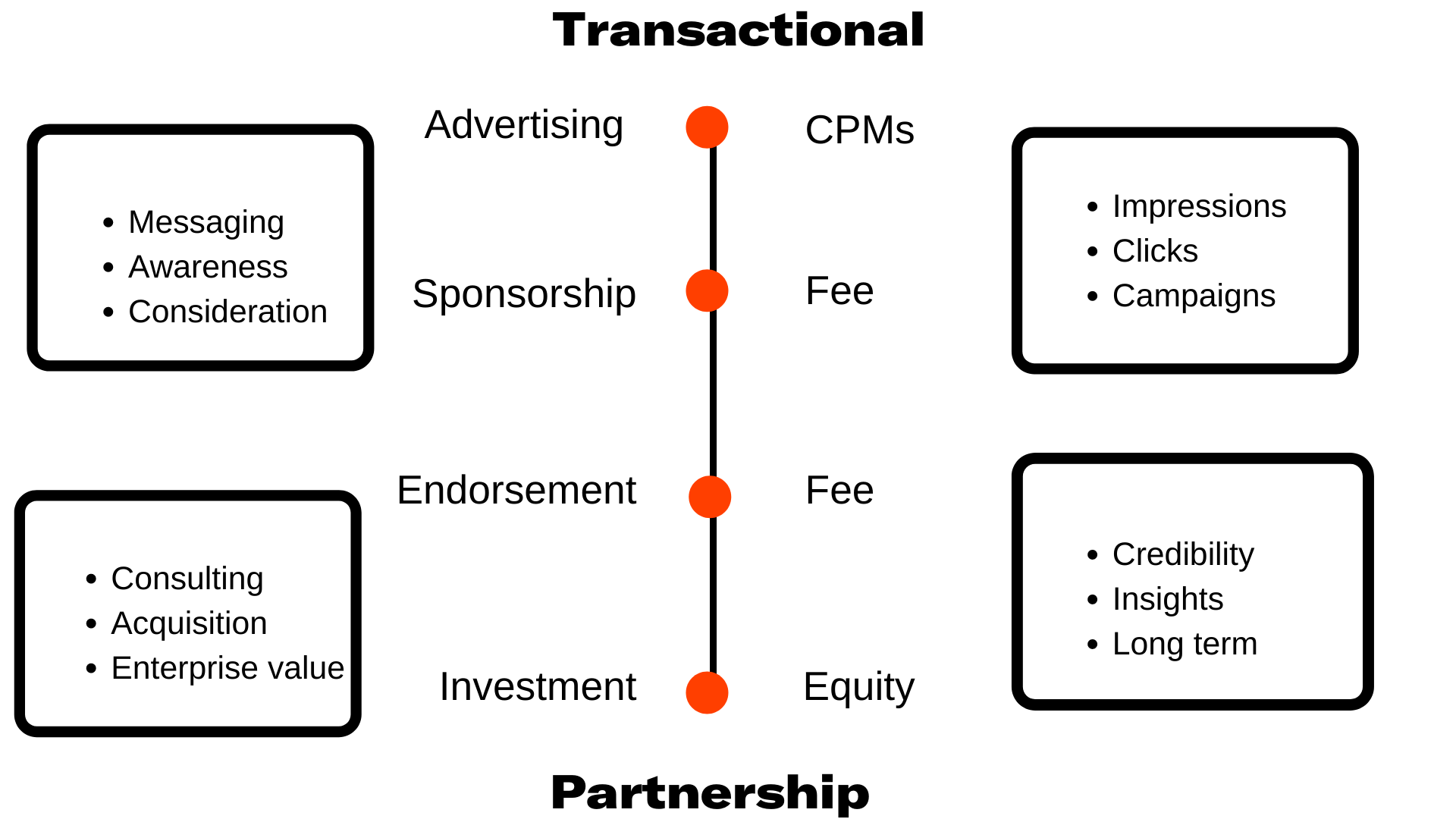Primary-engagement monetization
Niche media requires new ad products

Big thanks to George Montagu of FT Strategies for inviting me to Bracken House to talk to a group at the Financial Times. The FT is one of my favorite publications, so it was great to be on the inside — and to see the sweeping views of the city from the rooftop Japanese garden. Who said publishing’s fancy days are over?

In the early days of internet advertising, people talked a lot about Vogue. The reason is Vogue was as much about the ads as the editorial content. People in large part bought Vogue as much for the ads as the stories. For the sales side and the ad industry, this is nirvana. It was reminiscent of discussions I’d always hear from ad agencies about how the Super Bowl proved people actually really liked ads, just so long as they were sufficiently… creative.
File these in the lies media people love to tell themselves. Vogue and the Super Bowl are glaring exceptions to the norm, in which normal people rightly recognize advertising as a tax. Advertising has always been interruptive, designed to hijack your attention from what you’re doing. The dream of the seamless integration of ads and content ended up dying quickly as internet publishing became, for the most part, a direct-response medium that had more in common with the sketchiness of the junk mail world than the glamor of the red carpet at Cannes.
Native advertising was designed as a way to correct that. It was a good bet. After all, the one breakout hit of internet advertising was search ads that were, at their best, an improvement to the search experience. The problem ended up being that the internet is built on scale, and in battles of scale/efficiency vs niche/quality, scale/efficiency has won just about every single time. The entire concept of “programmatic native” was often an oxymoron, since creative native advertising that’s more than modern Yellow Pages listings is inimical to scale. That’s why publishers stopped bragging about their content studios and citing The New York Times “Orange is the New Black” native ad campaign.
But, as I wrote in March, I think we’re seeing the rebirth of native advertising in the area I call primary-engagement media, which is seen most prominently in newsletters and podcasts. The personal connection in both argue for a more hand-crafted approach to ads that is in stark contrast to the ValPak-ification of digital media. In my view, the way forward for niche media isn’t subscriptions-only. The answer is always to make money in several ways, and ads are still a great business. But the way advertising is done needs to be rethought. Few if any publishers could compete with platforms on efficiency. That’s going to get even worse with the march of retail media. You can bet that Amazon will be a massive presence at Cannes this year, which few would have expected when Jeff Bezos was calling advertising “the price you pay for an unremarkable product.”
The challenge of smaller, more focused publishing is finding a business model that aligns with your mission. The easiest approach is to simply do subscriptions, but while simple business models have many advantages, they don’t fit all missions. Indirect business models require “surfaces,” which incentivizes publishers to create more content in order to have more places to put ads. The only way around this is to refocus monetization away from the transactional nature of the pageview world and toward true partnership models that align with value creation rather than impressions.

By moving monetization closer to endorsements, primary-engagement media can create scarcity. The internet obliterated scarcity, but the tide is turning toward re-establishing this key tenet. The best endorsements are products the endorser believes in, and the relationship between the brand and the endorser goes beyond commercial messaging to include much more, even to the point of shaping product design. I’ve been tracking what Exec Sum and Bullish Studios have done with strip club operator Rick’s. This is the example of taking more of an endorsement approach rather than the typical advertising financial publications do. The same is driving, to a degree, the trend of niche expert newsletters becoming the front end for investment vehicles. See what Eric Seufert is doing with Mobile Dev Memo. He’s taking his deep expertise in mobile marketing and the community built around his published insights to source deals.
The advantages of these approaches is they do not need to scale. They should more tightly align editorial mission with the business model, which is nearly impossible to do with typical advertising approaches. Publishers often talk about “partnerships,” but they’re typically just slapping the term on what is usually a transactional arrangement that’s ruled by a spreadsheet. Primary-engagement media by its nature is more personal, which means more human approach to monetization are what is truly native.


When the Television Academy set out to create a unique viewing platform to stream For Your Consideration and Emmy-nominated content, it tapped Applicaster to build the complex app that would allow its Emmy-voting members to view nearly 2,000 hours of video content on six streaming platforms. Applicaster’s proprietary technology simplified the launch of over 100 content categories across six competition phases, delivering high volumes of unique content to thousands of voting members with different access requirements. Spend time growing your content business, not building the distribution technology.

Recommendations
My former colleague Jack Marshall was on the MediaVoices podcast to discuss how publishers should think about subscriptions – and why they’re not an either-or with advertising. Make money several ways.
There’s still money in media, only it more often tends to pool in companies that don’t fit the profile of the high-flying digital upstarts of the last era. Instead, venture capitalists are betting on companies like Recurrent, which look a lot more like Red Ventures and Dotdash than BuzzFeed.
Recessions are about human psychology, which is why consumer sentiment is an important metric to track when determining the economic outlook. With costs continuing to rise for essentials, subscription services are finding that people are doing the logical thing: They’re looking at what discretionary spending to cut. Netflix feeling the pain is a sign of more pain to come.
The bull market lasted so long, outside of the early Covid blip that was met with massive government liquidity, many are revisiting their managing-through-downturns playbooks. The name of the game: efficiency over growth.
The mechanics of subscription products tend to lead to a decision about how much to lean into strategies like decoy pricing and more complicated offers vs a simple offer, as Bild moved to. The advantages of a simple strategy go beyond raw conversion numbers. Simple approaches also garner trust, since people tire of all the games played with dark patterns like decoy offers, cheap intro pricing that balloons without notice, call-to-cancel, etc.
One effect of the impending recession is companies will end up reeling in their kid gloves approaches to hot button issues. Netflix making clear that it’s in the business of free expression is one of the more muscular approaches companies will take as they get pulled in all kinds of directions.

Thanks for reading. Please send me your feedback at bmorrissey@gmail.com.




